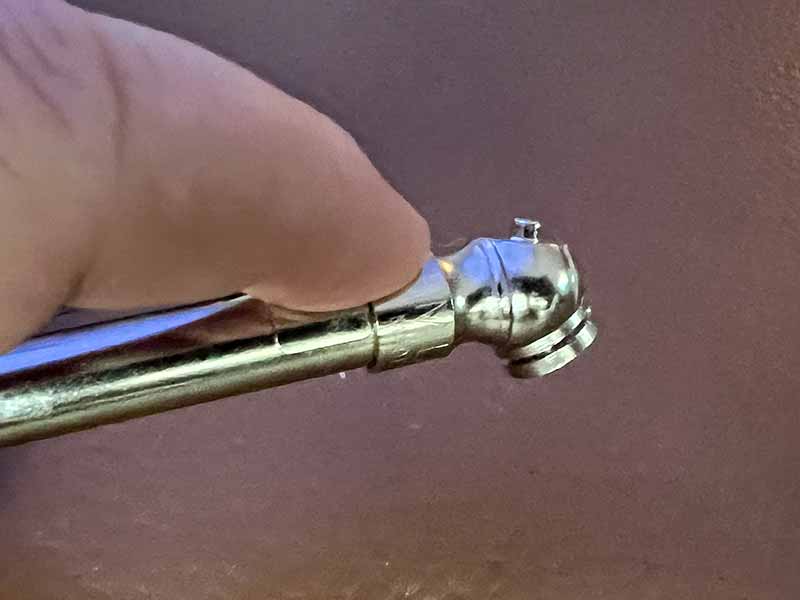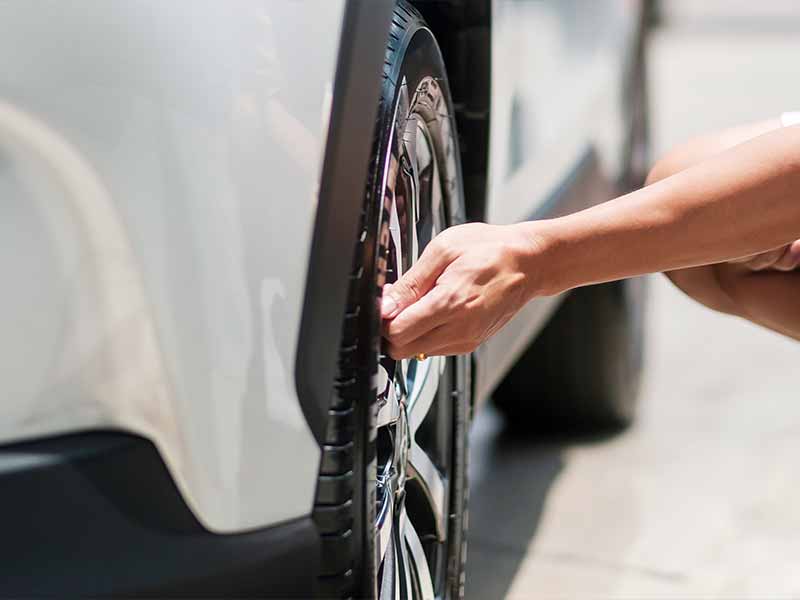How do you get air out of a tire fast? Overinflated tires are dangerous, so it’s important to maintain the recommended tire pressure listed in your owner’s manual or the tire information sticker inside the driver’s door jamb.
How To Let Air Out Of A Tire
To let the air of a tire, gently press a screwdriver or blunt object against the metal pin in the valve stem to release air.
Here are some faster and more accurate methods:
- Tire gauge with a bleeder valve
- Valve core removal tool
- Automatic tire deflator
In this article, we’ll explore various methods to deflate your tires, from the trusty tire pressure gauge to the ingenious automatic tire deflator.
Let’s take a closer look.

Slime 4-Way Valve Core Removal Tool
Valve Core Removal
If you want to let all the air out of a tire quickly, removing the valve core from the valve stem is the fastest way. It’s not very practical for only letting air out of your tire to get down to an ideal tire pressure, though. Here’s the process.
First things first: grab your valve core removal tool. It’s a nifty little gadget that’s super affordable and easy to find at any auto parts store. It has a small forked end specifically designed to fit onto the valve core, making the job a breeze. If you don’t have one, trust me, it’s worth the investment! It’s possible to use needle nose pliers, but they can be frustrating and challenging.
Locate the tire valve stem. Unscrew the valve cap, which is usually a small plastic cap, and set it aside. You’ll want to keep it safe so you can put it back on later. The valve core is a tiny brass piece inside the stem.
Insert the forked end of the valve core removal tool into the valve stem, making sure it’s firmly seated on the valve core. You’ll feel it catch as it slides into place. Gently twist the tool counterclockwise to unscrew the valve core. You’ll hear the air start to whoosh out as soon as it begins to loosen. It can be a bit loud, so don’t be startled!
Slime 4-Way Valve Core Removal Tool
Once the valve core is completely removed, the air will gush out quickly, so be prepared. Hold onto the valve core – it’s small and easy to lose, and you definitely don’t want that to happen.
When the tire is completely flat, simply screw the valve core back in using the tool, turning it clockwise this time. Make sure it’s snug, but don’t overtighten it. Finally, put the valve cap back on, and you’re good to go.
Automatic Tire Deflators
Automatic tire deflators make deflating your tires a piece of cake, and they’re perfect if you want to get the job done quickly and accurately. Let’s jump right in and get you up to speed using an automatic tire deflator.
First off, you’ll want to get your hands on an automatic tire deflator. They’re available at most auto parts stores or online retailers and come in various designs and price ranges. Some even have built-in pressure gauges, so you can easily monitor the tire pressure while it’s deflating. Pretty cool, huh?

Once you have your deflator, unscrew the valve cap and set it aside. You’ll want to keep it safe so that you can put it back on later.
Now, it’s time to break out your automatic tire deflator. These devices usually have a threaded end that screws onto the valve stem. Hold the deflator to the valve stem and rotate it clockwise to attach it securely. Make sure it’s snug, but don’t overtighten it – you don’t want to damage the valve.
The automatic tire deflator will release air from the tire when you adjust it to let air out. Various deflators work a bit differently, so be sure and follow the instructions provided with your deflator.
If your deflator has a built-in pressure gauge, you can easily keep an eye on the process. If it doesn’t, you may want to overshoot the pressure you’re going for and then use a portable air compressor to accurately air it back up to the desired pressure.
Tire Pressure Gauge Bleeder Valve
Using a gauge with a bleeder valve is super handy because it lets you monitor the tire pressure while you’re releasing air, making it easier to hit that sweet spot.
You’ll need an air gauge with a built-in bleeder valve. The bleeder valve is usually a small button or lever on the gauge that, when pressed, releases air from the tire. You can find these at most auto parts stores or online retailers, and they’re a great addition to your toolbox.

Jaco Elite Tire Pressure Gauge – 60 PSi
Once you’ve got your tire gauge with a bleeder valve, press the air gauge onto the valve stem, making sure it’s properly seated. The gauge will display the current tire pressure, giving you a starting point to work from. You should hear a slight hiss of air as the gauge makes a connection, but don’t worry – that’s totally normal.
Press the bleeder valve on the gauge to let air out of the tire. Air will escape through the gauge, allowing you to deflate the tire while still monitoring the pressure. Keep an eye on the gauge as the pressure drops, and when you reach the desired pressure, simply release the bleeder valve to stop the flow of air.
Remove the gauge from the valve stem and replace the valve cap. That’s it – you’ve successfully released air from your tire using an air gauge with a bleeder valve!
Jaco Elite Tire Pressure Gauge – 60 PSi
Tire Pressure Gauge Deflating Bump
This method is easy but not as convenient as using a gauge with a release valve. First, you’ll need a tire gauge with a deflating bump. The deflating bump is a small protrusion on the gauge, usually near the connection point, that’s designed to let the air out of the tire when pressed against the valve stem. You can find these at your local auto parts store or online retailers.
Press the tire gauge onto the valve stem, making sure it’s properly seated. The gauge will display the current tire pressure, giving you a starting point to work from.
To let air out of the tire, position the deflating bump on the gauge so it’s pressing against the valve stem. You’ll feel it depress the valve, allowing air to escape from the tire.

Since using a deflating bump doesn’t allow you to monitor tire pressure as the air releases, you’ll have to periodically check your tire pressure to see how much you’ve released.
You’ll want to have an air compressor of some kind handy to be able to add air back into your tire if you overshoot the mark. I recommend owning a portable air compressor you can keep in your car or truck. But if you don’t have one, you can try your luck at your local gas station and hope they have a functioning air pump.
Screwdriver Or Other Blunt Tool (Without A Gauge)
While using a screwdriver is not the most elegant method, it can definitely get the job done in a pinch. Let’s walk you through the process.
Before we start, keep in mind that using a screwdriver or blunt tool isn’t the ideal way to release air from a tire. It’s a makeshift approach when you don’t have the proper tools handy, so investing in a tire pressure gauge or an automatic tire deflator tool for future tire deflation needs is best. But hey, we’ve all been there, right?
Now, grab your screwdriver or blunt tool. The goal is to use it to press the small metal pin in the center of the valve stem, which will let air out of the tire. A flat-head screwdriver or the blunt end of a pen or pencil will do the trick.
As soon as the metal pin is depressed, you’ll hear the air hissing out. Keep a close eye on the tire as it deflates, and periodically remove the tool from the valve to check the pressure with a tire pressure gauge if you have one available.
Just like with the tire pressure deflating bump, you’ll probably want to have an air compressor handy to add a little air pressure if you let a bit too much air out.

Craftsman V20 Inflator Portable Air Compressor
How To Let Air Out Of A Tire At A Gas Station
Pull your car up to the air pump at the gas station. Park close enough to the pump so the air hose can comfortably reach your tires.
Grab the air hose from the pump. Press the hose nozzle onto the valve stem, making sure it’s properly seated. You’ll likely hear a brief hiss of air as the nozzle makes a connection, but don’t worry – that’s normal. Many gas station air pumps come with a built-in tire pressure gauge, so you can easily monitor the tire pressure while you’re deflating it.
If the pump’s nozzle has a bleeder valve (usually a small button or lever), press it to let air out of the tire while keeping an eye on the pressure gauge. If it doesn’t have a bleeder valve, you can gently press the nozzle against the metal pin in the stem to let air out, being careful not to apply too much force. Firmly press the nozzle onto the stem periodically to check the pressure on the built-in gauge. You’ll hear the air rushing out of the tire.
What Happens If You Put Too Much Air In Your Tire?
When a tire has too much air, the middle part of the tread tends to bulge out and make more contact with the road. This can cause uneven and accelerated wear, making your tires wear out faster than they should. Not only can this be a bummer for your wallet, but it can also lead to reduced traction and grip, which isn’t ideal for safe driving.
Overinflated tires can make your ride feel harsh and bumpy, as the tires won’t be able to absorb road imperfections as effectively. This might not be a big deal if you’re cruising down a perfectly smooth road, but let’s be honest – those are few and far between!
You might think that more air in your tires would lead to better gas mileage, and to some extent, that’s true. However, overinflating your tires can actually have the opposite effect. When the tire’s contact patch with the road is reduced due to overinflation, it can decrease traction and cause your car to work harder, leading to lower fuel efficiency. It’s all about finding that sweet spot!
Overinflated tires can be a safety risk. Too much air can make your tires more susceptible to damage from potholes, debris, or other road hazards. In some cases, overinflated tires can even lead to a blowout, which is a dangerous situation no one wants to experience.
How Do You Know How Much Air To Put In Your Tires?
You can usually find the tire pressure information on a placard or sticker on the driver’s side door jamb, inside the glove compartment, or in the owner’s manual. The tire pressure is typically expressed in pounds per square inch (PSI).
Keep in mind that the recommended tire pressure is based on cold tires. This means you should check and adjust your tire pressure in the morning or after your car has been parked for a few hours. When you drive, the tires heat up, which can cause the pressure to rise. So, it’s best to measure and adjust your tire pressure when the tires are cold to get the most accurate reading.
Resources
Below are some links you may find helpful when learning about tires
Final Thoughts
We’ve taken a journey through the world of tire deflation, exploring different methods to let air out of your tires like a true pro. Whether you’re adjusting tire pressure for off-roading adventures or simply maintaining the perfect ride, you’re now well-equipped to handle any deflation situation that comes your way.
Just remember to always put safety first and use the right tools for the job. They’ll get the job done faster and more easily without risking damage to your car or truck tires.
Good luck and happy motoring.








